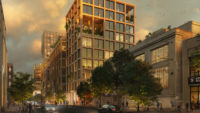Construction Regulations
NYC City Council OKs Hundreds of 'Major' Building Code Updates

New York City's building code updates will go into effect starting Jan. 1, 2022.
Photo: Metropolitan Transportation Authority / Patrick Cashin
A major update to New York City’s construction and building regulations includes more than 600 “major” changes and thousands of smaller ones as the city looks to improve safety and adapt to new technologies.
The City Council passed the legislation updating the codes Oct. 7. Construction safety updates include allowing the use of netting, low barriers and chain link fencing instead of requiring solid fencing that can create “blind tunnels” for pedestrians; the creation of a new type of license for advanced crane technology, to ensure that equipment such as articulating boom cranes and roto-telehandlers are operated safety; and improved consistency for underpinning existing buildings.
The updated codes also clarify the documentation needed for a new certificate of occupancy, and expand the types of allowed sustainable building materials such as cross-laminated timber and structural composite lumber. They also add a slate of safety enhancements designed to protect tenants and emergency responders, such as greater fire department access and amending inspection time frames for elevators and boilers.
Other updates focused on sustainability and resilience include expansion of flood zone requirements for critical facilities such as fire, rescue and ambulance departments, police stations, and emergency shelters; new mandates for inspections of floodproofing systems; and added support for alternative energy production processes such as hydrogen fuel cells.
Officials put together technical committees comprising members of the construction industry, including contractors, engineers, architects, attorneys and others to draft the code updates.
“Together with industry leaders, we contributed hundreds of significant revisions that will continue to drive safety in New York City’s construction industry while promoting the use of some of the most advanced materials and technologies,” says Brian Sampson, Associated Builders and Contractors Empire State chapter president. “Under this revised code, New York City will set an example for other large cities across the nation.”
City officials say its building codes are among the strongest in the world and often serve as a model for other cities. Buildings Commissioner Melanie E. La Rocca said in a statement that the updates “make our built environment safer for everyone living, working and visiting in our great city.”
The updates will go into effect in 2022, in some cases as soon as Jan. 1.
The new regulations come as the city Dept. of Buildings has cracked down on worksite safety.
As ENR previously reported, the department conducted three months of “zero tolerance” safety sweeps after seven fatalities at construction sites in the first five months of the year. Inspectors ended up visiting about 7,500 building sites, issuing 3,600 violations and 1,499 stop work orders.




